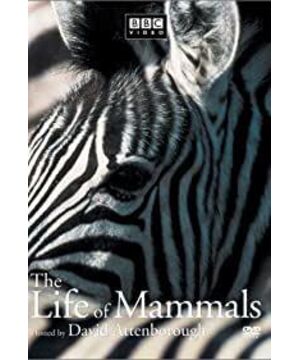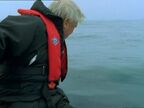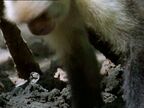Body temperature is a major factor in mammals' domination of the earth.
Africa's mammals are the most spectacular.
Blue whales are the largest creatures in history.
The ability of mammals to reproduce and adapt depends on their food.
Although echidnas have keen eyesight and hearing, they rely primarily on their sense of smell when foraging.
Waterfowl are the oldest living birds.
Breast milk is the perfect food, containing everything a young child needs to grow.
Echidna and platypus are the only remaining egg-laying mammals.
Due to the lack of nutrients in eucalyptus leaves, koalas eat almost every time they are awake, and sleep when they are full to save energy.
The Great Red Kangaroo is the largest of the kangaroo family.
The kangaroo's tail is like a fifth leg, supporting the body when kicking back or leaping forward.
A kangaroo jumping at full speed is faster than a horse.
Male kangaroos use smell to determine whether female kangaroos are in estrus, and then court for even days.
Web-footed possums are the only aquatic marsupials.
02-------------------
Cultivation of young is one of mammals' winning talents, and reptiles rarely do this.
Shrews have nipples near the shoulders, which makes feeding easier and helps slip away in a pinch.
The baby shrew is roughly full in less than a week and can run as fast as its mother.
How do hedgehogs mate? The answer, of course, is -- be careful.
Pangolins use only their hind legs to move around and use their tails to balance their bodies.
In terms of body size, the pangolin has the longest tongue of any mammal, and its saliva is the thickest.
After mammals appeared, it took another 60 million years for social insects to emerge.
Giant anteaters sleep 15 hours a day.
The giant anteater has the lowest body temperature of any mammal at 32 degrees.
The giant anteater has the largest claws of any mammal.
The giant anteater is of average intelligence, but its technique for dealing with termites is the most sophisticated of all creatures.
Fifty million years ago was a pivotal period in the history of mammals.
If termites haven't changed for 50 million years, why should the perfect structure of termite-eating animals change?
From the scrambled rat to the sky-soaring bat, this must be the most wondrous chapter in the history of mammals.
Long-eared bats do not hunt by sonar, but use their large ears to listen to their prey.
Natana's bat can see the tiny webs at a glance, and can catch spiders from the web with precision, and it even flies backwards to avoid getting caught in the web.
The number and density of Mexican pine-tailed bats is the highest among mammals in the world.
Mexican pine-tailed bats fly to an altitude of 3,000 meters at night to hunt for moths.
Pocket brown bats can survive the winter without food, known as hibernation.
Bats were among the first mammals to enter New Zealand, an isolated land in the South Pacific.
New Zealand bats love to eat earthworms.
Biological evolution rarely goes back, but bats hunt insects high up in the air and back to the ground.
03-------------------
Sloths are half blind and half deaf.
Sloths go to the ground once a week to defecate.
None of the mammals can digest cellulose on their own; they all rely on bacteria in their stomachs to break down the tight structures of plants.
Tapirs are the largest animals in the rainforests of South America.
Kaolin is a medicine, which is what we take to neutralize stomach acid when we have a stomachache.
Toxic substances in plants act as natural preservatives.
The grass should take advantage of the sun.
Elephants' dietary requirements make them salt-mining animals.
Wildebeest know the phosphorus content of grasslands well, so they only eat grass in one area and are not interested in other areas.
Although the wildebeest feed on their leaves, they do not damage the stems, so the grass can continue to grow.
Giraffes are the tallest herbivores on land.
Elephants are the mortal enemy of the gum arabic tree, and it will knock down the entire gum arabic tree.
Since most herbivores can't reach the topmost branches, acacia trees forget to grow spines there.
Elephant's stomach is so huge that food can stay there for three days.
If the eyes are on the sides of the head, you can see both the front and the back at the same time, which is a wide-angle field of view.
Herbivores sometimes even tease the beast to make sure it can't make a surprise attack.
The North American pronghorn is the second fastest animal on the planet, but it is the world champion when it comes to long distances.
In terms of body proportions, the horns of the American argali are the largest in the world.
Males smear mud on their horns to make themselves more threatening to other males and more attractive to females.
What you eat often determines what you are.
04--------------------
Rodents are good at biting things and can be described as invincible.
Unlike the incisors of other mammals, rodents regenerate constantly to fill in the wear and tear.
Rodents have become the most successful mammals with their amazing teeth, the largest of which is the mouse.
There are a total of 1300 species of rats in the world, and they are all seed thieves.
Squirrels are actually color blind.
Groundhogs are single-minded and stay with their mates for life.
The dams built by the beavers are so precise that the level of the 150-yard dam is only a few inches in error.
Autumn is the busiest season for beavers.
Beavers can stay underwater for 5 to 15 minutes.
The muskrats use reeds to pay rent, allowing beavers to make them sojourners and even eaters.
When naked hamsters meet, they judge each other's status by their sense of smell, and then the younger ones have to get under the elders' crotch.
Blindly digging nude hamsters rely purely on luck, so they often have to move dozens of them to forage.
After the whole people are barren and serve the mice wholeheartedly, this method is similar to that of bees and ants, but among mammals, only nude hamsters follow this system.
The grass rat builds nests on the reed stems to give birth to offspring, with a litter of up to eight, making it the most prolific rodent.
The capybara is the largest rodent in the world.
If the rabbit guinea pig is the antelope of South America, the capybara must be the hippopotamus of the rodent order.
Rodents are indeed the most adaptable mammals.
05-------------------
Mammalian muscles are the most energy-rich food.
There are two types of carnivores: one is feline and the other is canine. (and of course a few other subgroups)
Siberian tigers are the largest cats.
Guo Hu is the smallest fox.
Snake venom is deadly only when it enters the blood circulation, so as long as there is no wound in Guo Hu's mouth, he is not afraid of eating snake venom.
Fur seals are most afraid of enemies approaching from land.
Canines communicate by smell, and hyenas do it the most.
The South American bush dog is the most mysterious and unknown of the canine family.
The South American bush dog is the only canine with webbed feet.
South American bush dogs run in order, but not in order when they eat.
The open grasslands of Africa have the most meat in the world.
African hounds are the most successful hunters, with an 80% success rate.
The wolf howl is to warn the nearby wolves not to cross the border, but if the hunting time is too long and they become separated from each other, the howl also has the function of gathering companions.
The success rate of wolves in hunting is actually quite low, with an average of ten hunts only one success.
Most lions don't come out until night.
Lions have night vision eight times better than humans.
Lions are fierce and fierce, and it is hard to imagine that their family life can be so harmonious. The lions hunt together and raise their cubs together, and the lioness breastfeeds the children of the other members.
Most cats live and hunt alone.
When the cheetah is running at full speed, the speed is half as fast, and its feet are off the ground, almost flying.
Cheetahs are the fastest quadrupeds.
Among the big cats, the leopard has the strongest stealth ambush ability and the most secretive whereabouts.
When it comes to stealth and ambush skills or quick handling of prey, canines are not as good as cats.
Before humans developed weapons for themselves, the Siberian tiger was the most powerful killer in the world and an invincible predator.
06--------------------
Omnivores are the most adaptable animals.
Touch is a raccoon's strongest sense. Scientists believe that raccoons use their sense of touch to paint images of their surroundings in their brains, comparable to what the human eye sees. So raccoons can be said to see things with their hands.
Unlike human hands, a raccoon's hand does not lose its ability to sense even in icy water.
Dinosaur's teeth are like a universal toolbox that can handle a wide variety of foods.
The deer dolphin's sense of smell rivals that of any living or extinct omnivore.
Asian raccoon will give birth to about 15 litters.
Foxes will bury excess food. They are not cruel and easy to kill, but opportunists who know how to plan ahead.
Grizzlies love salmon.
A grizzly bear consumes 1 million calories throughout its hibernation period, essentially using up all of its energy reserves.
Some parts of the fish are fatter, and if there is a large supply of salmon, the grizzly will eat only the brains and eggs.
From an evolutionary perspective, specialization has always been a temptation.
The loss of natural environments has dealt a severe blow to global wildlife, but man-made environments have also provided new opportunities for many omnivores.
Urban raccoons are not as easily hit by cars as their country cousins, who have less experience judging speed.
Raccoons have become the most successful and widely distributed mammals in the Americas.
Foxes living in the countryside can become fully urbanized within a year.
Surveys show the red fox is one of the most beloved mammals in the UK.
The number of brown rats in the world is inexhaustible, and they are the supreme example of opportunism, and as a result they can be found all over the world, including Antarctica.
It can be said that the ruler of the earth is not a docile animal, but an opportunist.
07-------------------
By size, sea otters are probably the mammals with the largest appetite.
Sea otters call the sea their home, where they even mate and sleep.
Sea otters have the densest fur in the animal kingdom.
Seals cannot walk and can only crawl or slide when they come ashore.
Manatees also have toenails, remnants of the terrestrial age.
In fact, the Ganges dolphins have completely lost their sight.
The blue whale is the largest creature on Earth, twice as heavy as the largest known dinosaur.
A blue whale's nostrils can expel 90 percent of the used air from their lungs in one breath, compared with 15 percent in most land mammals.
Blue whales not only have oxygen in their blood, but also their huge muscle tissue, so they can stay underwater for more than half an hour.
Whales also call to each other, keeping in touch even when they are hundreds of miles apart.
Humpback whales in the same waters sing the same song.
Male right whales have the largest testicles in the world, weighing a ton and producing many gallons of sperm.
Male right whales will wash away the sperm left behind each time they mate, so the male whale who mates first is not necessarily the father, the finale is the real son.
08-------------------
The tail doesn't look like it's helpful for climbing, but it's a great help in maintaining balance.
No large mammal lives in a tree all its life, and they all move around in search of new food.
Female squirrels can mate with up to eight male squirrels a day.
The wing membrane of fruit bats is the fastest growing body tissue in many mammals.
Fruit bats can fly 30 to 50 kilometers a night.
Most fruit bat colonies have a pair of eagles nesting nearby.
The barren loris has long thumbs and no index fingers, so the fingers are wide enough to grasp thick branches.
Barren lorises wipe their hands with urine, so they leave scented tracks on tree branches as they climb.
The little night monkey leaps up to 30 times its body length.
Bamboo hearts are full of cyanide.
One golden lemur ate enough cyanide to kill 12 other animals of the same size.
Few prey animals can keep up with the speed of a long-tailed civet as it travels through a tree, and few animals can climb down a tree head-down like a long-tailed civet.
The gibbons are the fastest but incapable tree dwellers on the planet. They are fast and agile, and can even catch birds in mid-air.
Gibbons use their unique wrist joints to turn around instead of shoulder joints, which saves a lot of energy.
The researchers estimate that most gibbons have at least one fracture in their lifetime.
09-------------------
Rubbing lute leaves is a major social activity for capuchins.
The pygmy marmoset is the smallest monkey in the world, smaller than the palm of an adult.
There is only one kind of monkey in the world that gathers food at night, and that is the night monkey.
Female marmosets always give birth to twins.
The monkeys of West Africa's Tailin form the world's most bizarre anti-hunting alliance.
In baboon society, the baby is protected so you don't get beaten when you hold it. When smart baboons feel threatened, they use their babies as shields.
The size of a primate's brain is closely related to the size of its group, and the larger the group, the larger the brain.
500 miles away in the Ethiopian highlands lives the largest group of monkeys, the Griffon, the world's only herbivorous monkey.
10-------------------
Adult orangutans are notoriously misfits, forced to live apart due to food shortages.
In Litri, Tanzania, there is evidence that human ancestors walked on their feet 3.5 million years ago.
It takes an infinite amount of imagination to connect the footprints that animals left on the ground hours rather than days ago.
When running long distances, two feet are more efficient than four.
In fact, almost none of the species are suitable for breeding.
With the right technology, even deserts can grow crops.
Today, more than one-third of land is used to produce food for humans.
Humans are so good at inventing, exploiting the most inhospitable and useless corners of the planet, we've even begun to farm the oceans.
Maybe it's time to reverse the process, and instead of controlling the environment for the benefit of humanity, we should control the population to keep the environment alive.
View more about The Life of Mammals reviews








